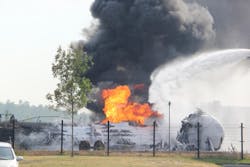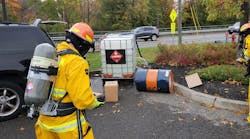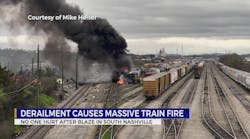With the advent of new technologies, production of crude oil from shale formations in North Dakota, Colorado, Pennsylvania and Texas has significantly increased the transportation of crude oil by rail and highway over the past several years. Correspondingly, there has been an alarming number of train derailments in the United States and Canada involving crude oil. One of the reasons the magnitude of these incidents has been so great is the number of train cars containing crude oil. Trains can have more than 100 cars, each carrying 30,000 gallons of crude oil to refineries. Derailments have also shown that typical tank cars used for transportation of crude oil have flaws that increase the risk to emergency responders and the public.
The oil boom
The increase in the production of crude oil in North Dakota and other locations in the United States and Canada comes from developments in technology involving horizontal drilling and hydraulic fracturing (aka fracking). The boom in oil production in North Dakota is primarily from the discovery of the Parshall Oil Field in Mountrail County in 2006.
Most crude oil in the United States is shipped to refineries through pipelines. Currently, there is limited pipeline infrastructure available to ship crude oil from some of these new oil fields, so it has to be shipped by a combination of truck and rail. The amount of oil moving by rail in the U.S. has spiked since 2009, from just over 10,000 tanker cars to over 400,000 in 2013—and it continues to increase.
The Bakken oil boom has propelled North Dakota into the top ranks of oil-producing states. As recently as 2007, North Dakota ranked eighth among the states in oil production. In 2008, the state overtook Wyoming and New Mexico. In 2009, it out produced Louisiana and Oklahoma. North Dakota surpassed California in oil production in December 2011 and then overtook Alaska in March 2012 to become the second most oil-producing state in the country, exceeded only by Texas.
Crude oil basics
Petroleum, or crude oil, is a mixture of hydrocarbons (compounds composed of carbon and hydrogen) and other chemicals. Crude oil hydrocarbons should not be confused with refined hydrocarbons that have many commercial uses in our everyday life, such as propane, butane and bitumen, which all come from the same barrel of crude oil.
The color and viscosity of petroleum vary markedly from one place to another. Most petroleum is dark brown or blackish in color, but it also occurs in green, red or yellow.
The elemental composition of crude oil includes the following: carbon 83–87%, hydrogen 10–14%, nitrogen 0.1–2%, oxygen 0.05–1.5%, sulfur 0.05–6% and metals less than 0.1%. Hydrocarbons found in crude oil range from having only one carbon (methane or natural gas) to having 50 (pentacontane).
Four main types of hydrocarbons are found in crude oil: paraffins 15–60%, naphthenes 30–60%, aromatics 3–30%, with asphaltics making up the balance. Paraffins, also known as alkanes, are single-bonded hydrocarbons considered to be saturated. They contain 20 to 40 carbons in the compounds. Naphthenes are cyclic single-bonded hydrocarbons that end in “-ane,” such as cyclohexane. Aromatics are an organic molecule containing the benzene ring. Asphaltics is a term associated with asphalts, a class of solid to semi-solid hydrocarbons derived from crude oil.
Crude oil classifications and hazards
Crude oil is a Class 3 flammable liquid under the U.S. Department of Transportation (DOT) Hazard Classification System. Because it is transported in bulk, it has a United Nations (UN) four-digit identification number of 1267, which appears in the center of a red flammable liquid placard or in an orange rectangle near a flammable liquid placard. NFPA 704 fixed-facility marking system hazards for Crude oil are Fire-3, Health-2 and Reactivity-0.
Crude oil flammable characteristics can vary greatly depending on where the crude oil is found in nature. Because crude oil is a mixture of hydrocarbons rather than a pure compound, and mixture components can vary, it is difficult to determine exact physical properties of any one crude oil mixture. Boiling point, flash point, flammable range, vapor pressure, vapor density and specific gravity are all important physical characteristics to know when dealing with emergencies involving flammable liquids. But because crude oil is a mixture of hydrocarbons, information on physical characteristics of a given mixture may not be available. In general, the flash point of a crude oil is below 50 degrees F (10 degrees C) and the boiling point is below 95 degrees F (35 degrees C). Vapors from a crude oil spill will likely be heavier than air and pool in low-lying areas. Response resources such as the Emergency Response Guide Book (ERG), Material Safety Data Sheets (MSDS), CHEMTREC and the National Response Center should be used initially to obtain information about crude oil incidents.
Crude oil from the Bakken Region of North Dakota is considered by some to be more volatile than “normal” crude oil from other areas. When responding to an accident involving crude oil, you need to understand that it is a flammable liquid. That means if the crude oil is not already on fire, it will burn, and you need to take precautions like you would with any flammable liquid that has been released from its container. If a flammable liquid is already on fire, none of the physical characteristics really matter at that point. Focus needs to turn to tactics to deal with the fire conditions.
Water and foam tactics
Crude oil is considered a heavy hydrocarbon, which is usually difficult to get to burn. However, once burning, they have a high heat output and are very difficult to extinguish. Water does not work well by itself for extinguishing flammable liquid fires. The specific gravity of flammable liquids, and specifically crude oil, is less than one and is not miscible with water, so it will float on the surface of water. This may allow burning crude oil to spread.
Water should be used to cool tanks, protect exposures and to extinguish exposure fires if these things can be accomplished safely. Unmanned monitors should be used for water and foam applications. According to the NFPA, a minimum of 500 gpm is required for tank-cooling operations.
Effective extinguishment of crude oil fires requires the use of hydrocarbon foam concentrates and appliances for application of foam. Crude oil fires require a certain amount of foam to extinguish a given volume of flammable liquid fire. Once extinguishment is accomplished, a blanket of foam needs to be maintained on spilled liquids to prevent re-ignition. The bigger the fire, the more foam required.
Many fire departments do not immediately have access to large quantities of foam, hampering their extinguishment tactics until enough foam concentrate can be brought to the incident scene. It is a waste of time and foam concentrate to apply foam to a flammable liquid on fire or to lay down a foam blanket if there is not enough concentrate available to accomplish the task. Initial tactical objectives may be limited to defensive actions, including protection of personnel and the public through evacuations—while letting the fires burn. Offensive tactics will often place emergency response personnel at greater risk.
Dangerous scenarios
Trains carrying crude oil can be over a mile long with more than 100 tank cars. If a derailment occurs, thousands of gallons of product can be released from derailed tank cars. Several possible scenarios exist when a train derailment occurs involving crude oil tank cars:
- Pool fire—a leak occurs, liquid pools and ignites
- Flame impingement on tanks
- Tank rupture with possible fragmentation
- Fire balls
- Flash fires—fuel vapor ignites at a point beyond the release
Most emergency response agencies will not have immediate resources or trained personnel to safely respond to such an event. This type of incident will require specialized equipment and trained personnel, and these resources may be hours away. Railroads should be contacted immediately through one of the contact numbers provided depending on which railroad is involved.
By far, the worst train derailment involving crude oil occurred in Quebec, Canada, on July 6, 2013. This derailment occurred in downtown Lac-Megantic and resulted in 47 civilian fatalities and destroyed more than 30 buildings. Fire departments from Canada and Maine responded to the massive fires in Lac-Megantic.
The train had been parked on the main line 7 miles outside of town. During the night, a fire occurred in one of the locomotives on the parked train. The fire department responded and extinguished the fire, and railroad employees declared the train safe. Brakes failed to hold the train in place following the engine fire, and sometime after midnight the train started to roll downhill toward Lac-Megantic. Sixty-three of the train’s 72 cars derailed near a grade crossing at the main street in downtown. Derailed tank cars immediately caught fire, and between four and six explosions were reported by witnesses.
Hazards and response recommendations
Crude oil is typically carried on trains utilizing “legacy” DOT-111 and in some cases the newer CPC-1232 tank cars. The National Transportation Safety Board (NTSB) has flagged the DOT-111 tank car as unfit to haul crude oil and ethanol because the car is prone to puncture in the event of a derailment. CPC-1232 tank cars have half-head shields installed to protect from punctures. However, the cars have been involved in derailments with resulting fires and thermally failed in at least four derailments resulting in explosions. The NTSB has further determined that both the DOT-111 and CPC-1232, which are non-thermally protected, are vulnerable to thermal failures. The NTSB wants these cars to be equipped with jackets, thermal protection and appropriately sized pressure-relief devices that allow for the release of pressure under fire conditions. The NTSB believes that the 10-year deadline for retrofitting or removing from service CPC 1232 tank cars is excessively long. Crude oil production in North America is expected to increase by more than 5 million barrels per day by 2024.
According to DOT’s Pipeline and Hazardous Materials Safety Administration (PHMSA), “The size, scope and resources needed to successfully manage a crude oil rail transportation incident will overwhelm the capability of most emergency response agencies.” They make the following transportation and planning recommendations for emergency response personnel for dealing with crude oil incidents:
- Responses to unit train derailments of crude oil will require specialized outside resources that may not arrive at the scene for hours; therefore, it is critical that responders coordinate their activities with the involved railroad and initiate requests for specialized resources as soon as possible.
- These derailments will likely require mutual aid and a more robust on-scene Incident Management System than responders may normally use. Therefore, pre-incident planning, preparedness and coordination of response strategies should be considered and made part of response plans, as well as drills and exercises that include the shippers and rail carriers of this commodity.
- Evaluate the risks of personnel intervening directly in the incident. Consider the limitations of people involved and the ability to have adequate resources available on site (e.g., sufficient firefighting foam concentrate, water supplies, appliances, equipment, trained personnel and technical expertise) and the ability to sustain operations for extended periods of time (hours or days).
- For non-fire spill scenarios, have the concentrations of any flammable or toxic vapors present been determined using air monitoring instruments? What are the flammability and toxicity readings? Has the need for continuous air monitoring been properly evaluated and discussed with technical specialists? Can sources of ignition be removed and/or be eliminated? Are adequate foam supplies and equipment available for vapor suppression?
- Based on results of the hazard assessment and risk evaluation process, are there adequate resources available to respond to the scene within a reasonable timeframe so that intervention efforts will be successful?
In sum
If your agency is not fully prepared and capable in terms of resources, equipment and properly trained personnel to intervene, defensive or non-intervention strategies will likely be the preferred strategic option.






